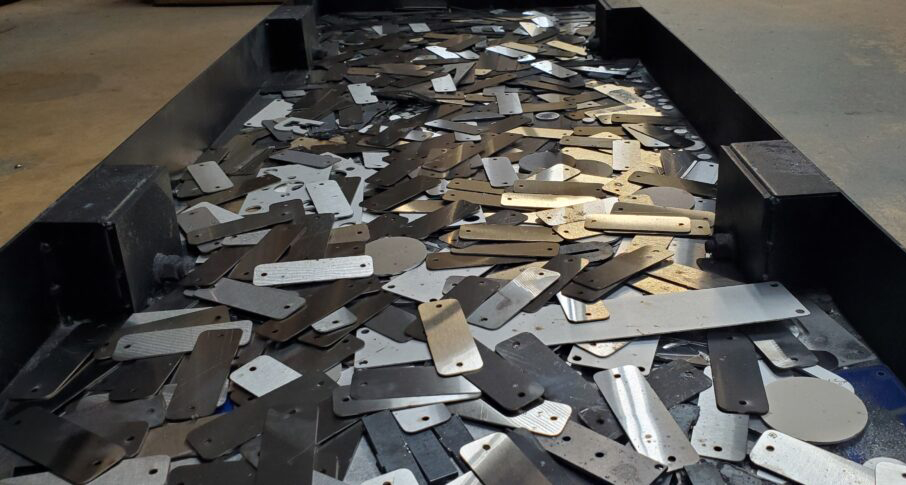Custom Cut Metal
Do you need to purchase Custom Cut Metal for some kind of application, that’s why you’re here. This guide will help you to decide on which material will best fit your requirements. We will start with a few basic questions to help determine the basis of what you need. We will discuss the following materials to offer guidance that pertains to your immediate tagging need and requirement.
Is your metal going to be subjected to harsh outdoor elements? Maybe it’s a sheet of metal simply being installed onto a control panel or power system that is kept indoors and within a climate controlled environment. Steel or Aluminum is always a sure bet – but which should you choose? Well that depends!
Anodized Aluminum VS. Stainless Steel
They are known as the best two materials in regards to harsh environments. Generally speaking I usually sway towards Aluminum as it’s light-weight and will not corrode. Stainless Steel can contain corrosive properties over long periods of time based on various chemicals, temperature and especially exposure to nature. The closer you are the ocean, the more likely you are to require aluminum.
Aluminum can be supplied in varying thickness from the ultra thin .003″ – .25″. When produced in a thin format such as .003″ – Aluminum can be extremely ideal for electrical equipment and machinery that may require barcoding, variable data, or information that specifically applies to inventory and tracking. Proper examples would be power supplies, small motors, pumps, laptops or tablets issued in bulk volume throughout an organization. Thin Aluminum labels and Metal Tags are difficult to remove and can be produced in a tamper-proof format to help discourage theft. Aluminum can come in different finished, raw or anodized depending on the application.
Stainless Steel can be supplied in varying thickness, but the background is always a chromium type finished. Sometimes brushed Metal Tags and Data plates that are manufactured out of Stainless Steel are ideal for harsh environments where they are subjected to physical abuse and chemical abuse. (physical impact or solvents/chemical agents).
Aluminum and steel, widely employed metals in various industries, share core similarities but exhibit distinct characteristics, particularly in bending and cutting processes. A common trait is their machinability, as both metals are well-suited to precision cutting and bending, facilitated by technologies like CNC machining. Their shared strength makes them suitable for structural applications where durability is crucial.
Versatility is another shared aspect, with both metals finding applications in construction, automotive, aerospace, and other industries due to adaptability to different manufacturing processes. Their versatility extends to recyclability, contributing to sustainable manufacturing practices, aligning with the emphasis on eco-friendly processes. However, pivotal differences set these metals apart. Notably, steel is denser, contributing to higher overall weight, making aluminum the preferred choice where weight is critical, such as in aircraft components.
Orders Made Simple – with Fast Direct Shipping
Straight to You or the Jobsite!
Corrosion resistance differs, with aluminum forming a protective oxide layer, offering excellent corrosion resistance, while steel may require coatings like galvanization. Formability varies, with aluminum being more malleable and ductile, making it easier to form and bend, especially for intricate shapes.The strength-to-weight ratio is crucial; although steel is generally stronger, aluminum has a higher strength-to-weight ratio, vital in applications where minimizing weight without compromising strength is essential, such as aerospace.
Heat conductivity is another differentiator, with aluminum having superior heat conductivity, making it suitable for applications requiring effective heat dissipation.Cost considerations influence material selection, with aluminum generally being more expensive than steel. However, the overall cost comparison is nuanced, depending on project requirements, volume, and specific alloy grades.
Aluminum and steel offer unique advantages in bending and cutting processes. Material selection depends on specific project requirements, including weight considerations, corrosion resistance, heat conductivity, and cost, prompting manufacturers to carefully evaluate these factors for informed decisions aligned with industry standards. Proper application examples would be motors, boiler systems, heat exchangers, power systems or engine parts. Stainless steel Metal Tags do not contour very well, but it sure does hold up and is easy to clean. A large majority of Metal Tags and Data plates are made from Stainless Steel for reasons of durability, aesthetics and sanitary properties. It is very easy to wipe down stainless and it cleans up nicely!
Steel – Aluminum : Bending and Forming
Economical steel is commonly used in simple construction, disposable/temporary installations or painted parts. It can be Hot Rolled, Cold Rolled, Electro Galvanized and more for your custom cut metal project. Brass can be supplied in varying thickness though it’s much harder to cut with a laser. Brass is ideal for harsh environments where they are subjected to physical abuse and chemical abuse. However Brass is known to tarnish over time into a red or greenish color.
Proper application for Brass Tags would be valves, pumps, boiler systems, heat exchangers, or power systems. Brass does not contour very well around a part due to the thicker nature, but it sure does hold up and is easy to clean. A large majority of Metal Tags are made from Brass for reasons of durability, aesthetics and sanitary properties. It is very easy to wipe down stainless and it cleans up with ease!
Do you have a need for custom cut metal?
Got A Project?
Fill Out This Quick RFQ Form
– OR –
Email Us Directly!
800-482-1553
Monday – Friday : 9am – 5pm EST
Laser Fabrication:
Laser.us
LaserEngravingPros.com
MetalTagMaker.com
EngravedSwitchPlatesNOW.com



